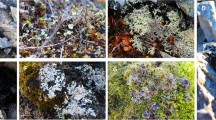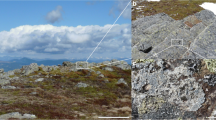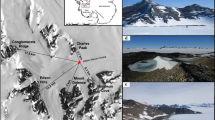Abstract
Lichen-forming fungi have been assumed to be more or less restricted to the surface of the substrate on which they grow, Conclusive identification of hyphae or an assessment of the fungal diversity inside lichen-covered rock has not been possible using methods based on direct observation. We circumvented this problem by using a DNA sequencing approach. Cores were drilled from a Devonian arcosic sandstone rock harboring the crustose lichen Ophioparma ventosa (L.) Norman on the surface. The cores were cut vertically, and DNA was extracted from the pulverized rock slices. A series of polymerase chain reactions using fungal-specific primers as well as Ophioparma ventosa specific primers were employed to amplify the internal transcribed spacer region of the nuclear ribosomal DNA. The results show that hyphae of O. ventosa penetrate approximately 10–12 mm into the rock. Consequently, the hyphal layer formed by the lichen fungus inside the rock could be 7–12 times as thick as the symbiotic thallus at the surface of the rock. In addition, eight non-lichenized fungal taxa and five that could not be identified to species were encountered. One fungal species in the order Helotiales occurs in six of the eight cores. The significance of these results to the colonization and weathering of rock by lichenized fungi is discussed.

Similar content being viewed by others
References
Altschul SF, Madden TL, Schäffer AA, Zhang J, Zhang Z, Miller W, Lipman DJ (1997) Gapped BLAST and PSI-Blast: a new generation of protein database search programs. Nucleic Acids Res 25: 3389–3402
Armstrong RA (1988) Substrate colonization, growth, and competition. In: Galun M (Ed.). Handbook of Lichenology, vol. 2, CRC Press, Boca Raton, FL, pp 3–16
Ascaso C, Wierzchos J (1994) Structural aspects of the lichen–rock interface using back-scattered electron imaging. Bot Acta 105: 251–256
Ascaso C, Wierzchos J (1995) Study of the biodeterioration zone between the lichen thallus and the substrate. Crypt Bot 5: 270–281
Banfield JF, Nealson KH (1997) Geomicrobiology: interactions between microbes and minerals. Rev Mineral 35: 1–448
Barker WW, Banfield JF (1996) Biologically versus inorganically mediated weathering reactions: relationships between minerals and extracellular microbial polymers in lithobiontic communities. Chem Geol 132: 55–69
Barker WW, Banfield JF (1998) Zones of chemical and physical interaction at interfaces between microbial communities and minerals: a model. Geomicrobiol J 15: 223–244
Bjelland T, Thorseth JH (2002) Comparative studies of the lichen–rock interface of four lichens in Vingen, western Norway. Chem Geol 192: 81–98
Bridge PD, Hawksworth DL (1998) What molecular biology has to tell us at the species level in lichenized fungi. Lichenologist 30: 307–320
Crous PW, Kang J-C, Braun U (2001) A phylogenetic redefinition of anamorph genera in Mycosphaerella based on ITS rDNA sequence and morphology. Mycologia 93: 1081–1101
Friedmami, EI (1982) Endolithic microorganisms in the Antarctic cold desert. Science 215: 1045–1053
Gaurdes M, Bruns TD (1993) ITS primers with enhanced specificity for basidiomycetes—application to the identification of mycorrhizae and rusts. Mol Ecol 2: 113–118
Gelirmann C, Krumbein WE, Petersen K (1988) Lichen weathering activities on mineral and rock surfaces. Stud Geobot 8: 33–45
Henssen, A, Jahns, HM (1973) Lichenes. Eine Einführung in die Flechtenkunde, Georg Thieme Verlag, Stuttgart
Jahns HM (1988) The lichen thallus. In: Galun M (Ed.). Handbook of lichenohgy, vol l. CRC Press, Boca Raton, FL, pp 95–143
James PW, Brightman FH (1992) Ophioparma Norman (1853). In: Purvis OW, Coppins BJ, Hawksworth DL, James PW, Moore DM (Eds). The Lichen Flora of Great Britain and Ireland. Natural History Museum Publications, London, pp 415–416
Kappen (1993) Lichens in the antarctic region. In: Friedmann EI (Ed.) Antarctic microbiology. Wiley-Liss, New York, pp 433–490
Lee MR, Parsons I (1999) Biomechanical and biochemical weathering of lichen-encrusted granite: textural controls on organic-mineral interactions and deposition of silica-rich layers. Chem Geol 161: 385–397
McLean CB, Cunnington JH, Lawrie AC (1999) Molecular diversity within and between ericoid endophytes from the Ericaceae and Epacridaceae. New Phytol 144: 351–358
Nash TH (Ed,) (1996) Lichen Biology, Cambridge University Press, Cambridge
Ott S (1987) Reproductive strategies in lichens. Bibl Lichenol 25: 81–93
Piervittori R, Salvadori O, Laccisaglia A (1994) Literature on lichens and biodeterioration of stonework. I. Lichenologist 26: 171–192
Piervittori R., Salvadori O, Laccisaglia A (1996) Literature on lichens and biodeterioration of stonework. II. Lichenologist 28: 471–483
Piervittori R., Salvadori O, Laccisaglia A (1998) Literature on lichens and biodeterioration of stonework. III. Lichenologist 30: 263–277
Renker C, Alphei J, Buscot F (2003) Soil nematodes associated with the mammal pathogenic fungal genus Malassezia (Basidiomycota: Ustilaginomycetes) in Central European forests. Biol Fertil Soils 37: 70–72
Schuler GD (1998) Sequence alignment and database searching. In: Baxevanis AD, Ouellette BFF (Eds). Bioinformatics. A Practical Guide to the Analysis of Genes and Proteins. John Wiley & Sons, New York, pp 145–171
Sterflinger K (2000) Fungi as geologic agents. Gemicrobiol J 17: 97–124
Ueda T, Suga Y, Yahiro N, Matsuguchi T 1995 Molecular phylogenetic analysis of a soil microbial community in a soybean field. Eur J Soil Sci 46: 415–421
White TJ, Bruns TD, Lee S, Taylor J (1990) Amplification and direct sequencing of fungal ribosomal RNA genes for phylogenetics. In: Innis MA, Gelfand DH, Sninsky JJ, White TJ (Eds). PCR protocols: A Guide to Methods and Applications, Academic Press, San Diego, pp 315–322
Acknowledgments
We thank Dr. Ingunn H. Thorseth and Ms. Linda Sæbø for help during the fieldwork, Mr. Jørn Einen for discussing the extraction method, and Dr. Martin Grube for valuable comments and discussion. We further thank the referees of this paper for useful comments and suggestions.
Author information
Authors and Affiliations
Corresponding author
Rights and permissions
About this article
Cite this article
Bjelland, T., Ekman, S. Fungal Diversity in Rock Beneath a Crustose Lichen as Revealed by Molecular Markers. Microb Ecol 49, 598–603 (2005). https://doi.org/10.1007/s00248-004-0101-z
Received:
Accepted:
Published:
Issue Date:
DOI: https://doi.org/10.1007/s00248-004-0101-z




